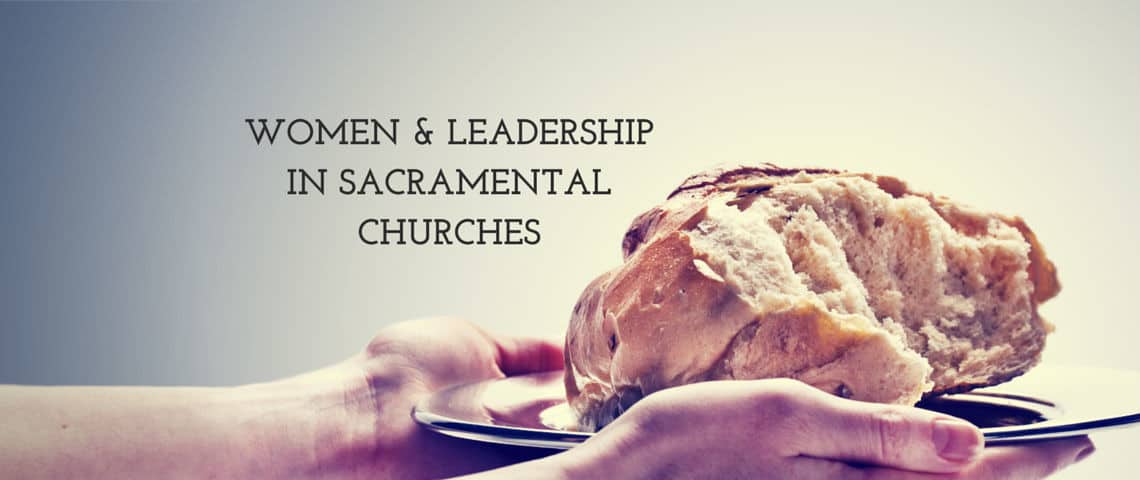When I was a pastor in the nondenominational world, most conversations around gender and church leadership revolved around whether women should preach from the pulpit, teach men, serve on an elder board, or hold the title of pastor. Complementarians claim these roles are reserved for men only, while egalitarians believe that women may lead in these ways. This is the conversation I lived in for many years, first as a complementarian pastor of a nondenominational church for 17 years, and then as an egalitarian, having shifted to an egalitarian view about ten years ago.
Since joining the Anglican Communion six years ago (a Christian community that is more sacramental in its theology), I have been introduced to a new set of conversations about gender and church leadership.
Sacramental Christians include Roman Catholics, Eastern Orthodox Christians, Anglicans and Lutherans. These four groups alone represent more than 1.4 billion Christians worldwide [1]. In this context, conversations about gender are quite different than in evangelical settings. (This is not to say that sacramental Christians cannot also be evangelical – I certainly am both.) For example, many sacramental complementarians have no objection to women teaching men or serving on governing boards. It is not uncommon to find women in complementarian congregations instructing both men and women in matters of theology, Scripture and spiritual practices. These roles are usually not a matter of contention or debate.
What is a matter of debate is whether women may preside over the Sacraments (serving communion), which can only be administered by ordained clergy [2]. Sacramental complementarians insist that women should not preside over the Sacraments; thus, they should not be ordained as priests or bishops. Egalitarians in sacramental congregations insist that women should preside over the Sacraments; therefore, they support the ordination of women.
Complementarianism looks different in sacramental churches, and centers around keeping women from administering the sacraments.
There are three arguments for this restriction that I want to address:
Argument #1 – Tradition
The first reason for not allowing women to administer Sacraments relates to Tradition. I use Tradition with a capital “T” because sacramental Christians believe there is a universal Tradition that has been passed on from the apostles to the Church today that must be upheld. When these congregations affirm their belief in the “holy catholic church” while reciting the Apostles ’ Creed, they are referring to the Latin meaning of the word, which means “whole” or “universal.” These churches deeply value the importance of Tradition, particularly the first five centuries of the Church, and claim that Tradition has always prevented women from being ordained and administering the Sacraments.
Although Tradition is very important to sacramental Christians, not all churches agree on how to interpret and apply Tradition, and just how authoritative this Tradition should be is a matter of debate. The historical reality is that while it was rare for women to serve in roles that granted them sacramental authority, it did occur.
Kevin Magidan and Carolyn Osiek’s Ordained Women in the Early Church: A Documentary History, an impressive anthology of ancient Christian texts, clearly documents that women were ordained to sacramental offices in both the Greek speaking East and Latin speaking West during the first five centuries of Church history. Women ordained as deacons and abbesses in monastic communities were often considered as fully ordained as male clergy. Moreover, women were known to hold the title of priest in both the Eastern and Western Church. This was indeed rare, which is not surprising given the patriarchal and often misogynist assumptions about women in antiquity. Tradition does not present a unified viewpoint on women presiding over Sacraments
Argument #2 – In the Person of Christ
In Western sacramental theology, the person presiding over the Sacraments is believed to operate in persona Christi (“in the person of Christ”). This is particularly the case when speaking the “words of institution” during the Eucharist, when the presider recounts Jesus’ words at the Last Supper. At other times the presider is believed to operate in persona Ecclesiae (“in the person of the Church”) on behalf of the worshippers. In some congregations, when operating in persona Christi, the presider faces away from the communion altar toward the people, but when operating in persona Ecclesiae, the presider faces the altar, turning away from the people.
Because of this theology (which not every sacramental tradition holds or expresses in exactly the same way), complementarians in the sacramental tradition argue that it is essential for the person presiding over a Sacrament to be a man, since Jesus was a man. Only as a man can the presider operate in persona Christi.
What happens with a priest or bishop presides over a Sacrament? The Western Latin tradition emphasizes the presider as in persona Christi, while the Eastern Greek tradition tends to talk of the presider as an icon of Christ. In both cases something unique is believed to occur during the sacramental rites. However, the argument that the presider must be male because Christ was male does not necessarily follow logically. Jesus was not merely a man; he was a first century Jewish man who lived in poverty.
Jesus was ethnically specific (Jewish), gender specific (male) and class specific (poor). To focus on just one and ignore the other two for the presider to function sacramentally seems arbitrary. Moreover, in Galatians 3:28 the New Testament specifically addresses all three of these traits—race, gender, and class–as being irrelevant to one’s being “in Christ”. No one argues that the presider must be Jewish or poor to function sacramentally. Thus it seems arbitrary to insist on gender for the presider to function in persona Christi or as an icon of Christ during a sacramental rite.
Argument #3 – Analogy of the Old Covenant Priesthood
A third reason offered for restricting administration of the Sacraments to men builds on an analogy between the Christian priesthood and Israel’s priesthood during the old covenant. Sacramental churches tend to emphasize a high level of continuity between the old and new covenants. Since the Levitical priesthood of the old covenant was restricted to men only, sacramental complementarians argue that the priesthood of the new covenant should be restricted to men as well. They suggest that women serving as Christian priests would be like Israelites outside of the clan of Aaron trying to serve as Levitical priests (see for example Numbers 16:1-42).
But the analogy with the old covenant priesthood is inconsistent with the teaching of the New Testament. Christ alone is our high priest, and his priesthood is not according to the requirements of the old covenant but “according to the order of Melchizedek”. Building on this idea, the author of Hebrews reminds us:
Now if perfection had been attainable through the Levitical priesthood– for the people received the law under this priesthood– what further need would there have been to speak of another priest arising according to the order of Melchizedek, rather than one according to the order of Aaron? For when there is a change in the priesthood, there is necessarily a change in the law as well.” (Heb. 7:11-12 NRSV)
Thus the New Testament itself insists that any priesthood existing among Christians would differ significantly from the old covenant priesthood. This should be obvious, since the old covenant priesthood was passed on by heredity. Moreover, men who suffered disabilities such as deformities, blindness, or mutilation were forbidden from serving as priests in the old covenant. To my knowledge, no one argues that such infirmities should prevent men from serving as priests in complementarian sacramental churches.
This is a basic overview of the arguments regarding gender restrictions in church leadership among sacramental churches. Far more can and should be said about this, but hopefully this is a direction for positive conversation on this topic. Understanding the issues at stake and lines of reasoning will help egalitarian Christians engage in more positive, thoughtful conversations regarding gender, the Church, and sacraments.
NOTES
[1] In addition to Roman Catholics, Eastern Orthodox Christians, Anglicans and Lutherans, sacramental Christians can be found in some Methodist and holiness groups as well. Sacramental congregations structure their corporate worship around the reading of Scripture (often from a lectionary) and the historic Christian Sacraments. This is not merely a stylistic difference from non-sacramental congregations. The liturgy in sacramental groups represents an entire theological framework. The two central Sacraments in these congregations are Baptism and the Eucharist; however, many sacramental Christians would also include confirmation, ordination, marriage, prayer for the sick, and confession of sin/penance. The Sacraments are believed to be a reliable means to receive God’s grace for those who participate in them through faith in Jesus Christ.
[2] In most of these groups there are three kinds of clergy: bishops (who are over groups of congregations), priests (also called presbyters or elders, who act as pastors over a single congregation), and deacons (who assist both bishops and priests). Different kinds of clergy can preside over different Sacraments, depending on the sacramental tradition of a particular congregation.





19 responses to “Women & Leadership in Sacramental Churches”
Thanks for this excellent post and good comments. I am a Lutheran and my background was in a church body that was complementarian. I used to use #s 2 and 3 myself to argue against the ordination of women. Now, as an egalitarian, I have to confront these arguments fairly consistently. This is a great resource, and I appreciate you writing it!
One approach that can be taken from a Lutheran standpoint is to note how Luther and the Lutheran Confessions each emphasize the work of God rather than the work of people in the sacraments. Because of this, I have drawn out how it should not matter if a woman is performing the sacrament rather than a man because it is ultimately God’s work, not our own.
I hope to write up a post of my own on this topic soon with some comments from your helpful piece here.
J.W., so looking forward to reading your post as I’ve been curious about the Lutheran take on things. Here is Southern Cal the Lutheran church seems to be pretty supportive of women, but I know that isn’t the case in some parts of the country.
Yeah it definitely depends
Somehow I sent the reply early. Anyway it definitely depends on the denomination that the church is as well. Which type of Lutheran will make a huge difference.
Thanks! This was very enlightening. I don’t come from a Sacramental Church background, so this is new information to me. I have been deeply studying the gender debate a little over a year now, and what is so clear is that the debate is really about what to do with women. It has been a painful and eye opening experience going from church to church trying to find a place belong. It’s hard walking into a churh when you feel like the leaders look at you as a problem to be solved or as a threat to godly order or as one who needs to be put/kept in her place. The whole idea of what is proper for women to do is very subjective. It is determined depending on who is in power or in charge. I now see that it changes from church structure to church structure. Thanks again! This opens a branch of study of which I was not even aware. May the Lord’s blessing be on you.
Thanks Leah. And as we say in my church, “and also with you.”
None of the three bases for restricting women from presiding over the sacraments holds water with me either, Tim, and for principally for the reason that they each fly in the face of Scripture.
This is fascinating and informative. Thank you, Tim.
I am on staff at my evangelical church, that, while not emergent, supports the ordination of women. Despite this, tradition and communal thought continually shows us almost exclusively male leadership; because of this, I was shocked when our pastor asked me to preside over communion. I was terrified (our church is not small), but I felt the significance of his request, so I agreed. Afterwards, our one woman deacon came up to me and thanked me for doing it. She said, “Women need to be seen up there. We need them; young women, old women, we need them.”
I share this anecdote as a means of encouragement; things are changing! God is good and he loves us all. I hope girls born with pastoral hearts continue to learn of their calling, unhindered.
Powerful story. Thanks for sharing it.
Loved reading about your experience of giving communion! Thanks for sharing your thoughts.
Very interesting to learn about the different things that evangelical and sacramental churches wrestle with. Thanks for the article. It was informative and enlightening.
Exactly what I was thinking – thanks Tim!
It struck me as particularly interesting that what is considered as biblically male-only is so very different across churches. It being not just something of degree (women can do only so much according to different churches) but of kind (in one church women can teach but not administer communion, in another administer communion but not teach) seems to say a lot.
Agreed, Lydia, it seems so arbitrary across the board.
Another issue that also must be considered is the nuptial mystery of Christ and the Church, as described in the “bridegroom-bride” analogy (Ephesians 5:21-33). Complementarians say that the nuptial meaning would be lost unless the priest images Christ who is male, and the Church is imaged as female (as is common in most languages). I think this reduces the mystery (Ephesians 5:32) to a rigid patriarchal interpretation, but this is where we are. For some working notes on this:
Nuptial Balance in the Priesthood and the Episcopacy
http://www.pelicanweb.org/solisustv11n07supp6.html#section9
Excerpt:
“The nefarious repercussions of conflating patriarchal ideology with revealed truth are evident in rigid masculinist interpretations of the Bridegroom-Bride analogy. Such interpretations tend to reinforce a mindset of male hegemony that is contrary to the mutual submission that is proper between husband and wife and intrinsic to the mystery of Christ and the Church. Jesus Christ is head of his body, which is the Church, because he is a divine Person and our Redeemer, not because he is male. In giving the power of the keys to Peter, he also submits himself to the Church even in the present age. The male-only Church hierarchy obscures our vision of the nuptial mystery of Christ as Giver-Receiver and the Church as Receiver-Giver. It obscures the Church as the family of God, a communion of persons in the image of the Trinity. It also serves to exacerbate antiquated patriarchal norms of male hegemony in Christian families.”
Excellent point Luis. I suppose my initial thought would be, if it is necessary for the presider to be male to function in Perona Christi during the sacrament to represent the nuptial mystery, wouldn’t it follow that the presider must be female to function in persona Ecclesiae since the Church is envisioned as all female? Great contribution. Thanks!